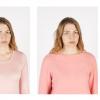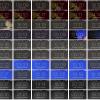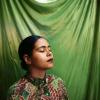These are the works/portfolios that were presented by the Master students in 2016.
Johan Poezevara, ESA Le Septante-Cinq
04/04/2016FANTASM
(overview of an European americanism)
___________
In the flood of images seen during a day, representations of the American popular culture have that special attraction force.
From mundane to extraordinary, they are rooted in habits, and it transforms them.
These pictures are the result of a questioning about the fantasy it causes here, on the old continent.
Mimesis, copy-paste - like a child's play -, the policeman turns into a rodeo champion, the thief into a nascar driver.
Benjamin Sandri, ESA Le Septante-Cinq
03/26/2016-The Latter Day Saints of Belgium-
The Mormon community counts more than 15 million members in the world, with about half of them in the United States. This religion stemming from Christianism was born in the New World during the XIXth century. This church is of course present on the Belgian soil and numbers around 5000 members coming from different countries and social backgrounds. Mormon parishes have similar, bare interior architectures, far from splendour and luxury. For them, it reflects their simplicity and modesty.
These photographs have a documentary purpose. They are not concerned with making a positive or negative statement on this religion, which could give a sectarian vision because of certain antecedents and present practices. They attest of these standardised places of worship, adorned with religious images and faces that frequent the parishes of the Latter Day Saints.
Nanó Wallenius, KASKA (Antwerp)
04/07/2016Dress for Success
The year was 2007. Like the hormonal teenager I was, I cried like a baby when my conscript boyfriend waved me goodbye at the train station. The evening before I had carefully shaved his hair. Again and again I tried telling myself that it is okay not to see him every single day. The same evening I packed my bags and traveled to Kungsholmen in Stockholm to stay with a family friend in order to think about something else for a week. This wasn’t exactly a brilliant idea. It didn’t take many days before I snapped. I ran to the park and sat down to cry on a giant stone. In the same time my boyfriend sent me a message - he didn’t want to be in the army anymore. Initially he wanted to choose community service over military service, but his dad had strongly opposed this.
___
Take it Like a Man
During my second year in upper secondary school, I, like most other second year students, wanted to participate in the annual old style dancing course. This course results in a dance show for the whole school to show that the second year’s now are the oldest students once the seniors have left school to start cramming for the final exams. During the dance show all the girls wear prom dresses and the boys wear tailored suits. I was very excited about this and I bought my dress a whole year in advance. It was turquoise with rhinestones all over the torso and a corset in the back. I asked a guy in my year if he wanted to be my partner for the dancing course and he said yes. The day of the first dance lesson was finally here and I saw my partner on the other side of our school’s gym hall. Another girl from my year was standing next to him. I asked him what was happening and he said he couldn’t remember me ever asking him to be my dance partner. I left class in fury, I withdrew my participation and I never wore my turquoise dress.
___
Only Last Spring I Started Wearing Pink
"Pink is a pale red color, which takes its name from the flower of the same name. According to surveys in Europe and the United States, pink is the color most often associated with love, beauty, charm, politeness, sensitivity, tenderness, sweetness, childhood, femininity, and the romantic. When combined with violet or black, it is associated with eroticism and seduction."
- Wikipedia
Sidney Terneu, KASK (School Of Arts)
04/04/2016“The part of life we really live is small. For all the rest of existence is no life, but merely time.” -Seneca-
The ancient Greeks had two words for time. Chronos, which refers to clock time (seconds, minutes, hours, so basically time that can be measured) and Kairos, which measures moments and not minutes. Where Chronos is quantitative, Kairos is qualitative.
Chronos is leading our modern society and creates the idea that time has to go forward really fast because it is so precious (the time-is-money-idea). This society has become a sped-up, over-crowded and over-connected high technological place, which bombards our minds almost non-stop with excessive stimuli, and time to step back and to process those stimuli is rare.
My work is about trying to escape the hectic and fast-moving flow of life and rid the mind of excess. By excessively capturing those moments of escape, I try to become aware of the, often brief, moments where I lose myself into reveries. Staring and creating order out of chaos by constructing grids are two ways thats help me to do that. The repetition of numbers is an other one. When one is able to rid the mind of the overabundance and come into a state of non-thinking one is able to stop noticing the passage of time (Chronos) and therefore is able to find space and time (Kairos) to process the excessive stimuli and find stillness or peace of mind.
Tomas Bachot, School of Arts/KASK
/Those who eat fish from the cyanide lake improve their sex life/
I have used the actual debate on the reopening of Romanian goldmines to explore the way in which a documentary story can be told. Within this quest the manipulation of the photographer plays a leading role.
“The only true voyage of discovery (…) would be not to visit strange lands but to possess other eyes.” (Proust)
As a documentary photographer I am a professional liar. With my project I represent the daily life in the gold area of Romania. There, foreign companies try to reopen old goldmines. On the one hand this could create jobs, but on the other hand there is the danger of an environmental disaster. When I showed the photos from my first trip to a Romanian family where I stayed, the mother was shocked. Literally she said: “these pictures have no value for me.” She pointed out that I depicted Romania as a stereotype of misery. She was right. Before I arrived in Romania I had already had a preconceived image in my head, mainly created by the media. I was only pursuing that image in my head on the ground. The truth depends of the photographer. Than why not play another photographer each trip? I went back seven times to the gold area, each time photographing with another approach. Last time I used a camera, which automatically reacts to movement and heat. This resulted in a more abstract image of the region. Working this way I aim to give an overview of the Romanian gold area that is as diverse as possible. Moreover I want to raise questions about the role of the documentary photographer. The different ‘truths’ will oppose each other. I hope the viewer will question the credibility of the photographer and the relativity of an image. At this moment I am working on a book, where pictures, diary fragments, maps and reactions from locals will be mixed.
Deborah CLAIRE - esa Le Septante Cinq
04/05/2016La femme. Son corps, son choix ? Évoluant dans une société ou la nudité est sur médiatisée, où les canons de beauté et de bienséance sont le choix d’hommes omniscients, quel est le rôle des femmes dans la réappropriation de leur image et face à l’objectification du corps sexuel féminin par les hommes, pour les hommes ? Qui sont ces femmes, maîtresses de leurs corps, de leur image et de leurs choix ? En 2016, ai je le droit de décider ce que je veux montrer, ce que je veux dire sur mon corps, ma sexualité ? Dans ce recueil de portraits, sorte de constat du paysage féminin et féministe actuel, se mêlent nos contemporaines. Des femmes qui par leurs métiers, leurs productions artistiques ou universitaires, leurs choix et surtout leurs actes pose la question de la sexualité par les femmes, pour les femmes et la monstration du corps féminin selon nos propres codes.






